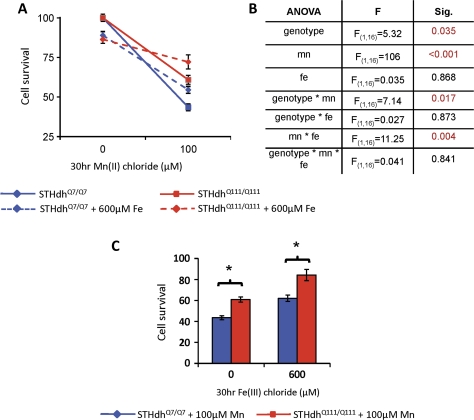FIG. 6.
Saturating levels of Fe have no significant effect on the HTT-Mn interaction. Wild-type STHdhQ7/Q7 and mutant STHdhQ111/Q111 cells (as indicated) were exposed for 30 h to Mn(II) chloride in the presence (dashed line) or absence (solid line) of 600μM Fe(III) chloride. (A) Cell survival by MTT assay was determined (n = 3 independent experiments, 4 wells per experiment) and graphed as mean survival (±SEM) normalized by the vehicle control (no Mn or Fe) for each genotype. (B) Table summarizes statistical analysis of three-way repeated measures ANOVA (genotype, Mn(II) exposure, Fe(III) exposure, and all two-way and three-way interaction terms); significant terms (p < 0.05) are indicated by shaded numbering. (C) Cell survival data for 100μM Mn(II) chloride exposure only, mean survival (±SEM) normalized by genotype and Fe(III) exposure to show the relative influence of Fe on Mn toxicity between wild-type and mutant cells (as indicated). Mutant cells show a significant increase in survival following Mn exposure both with and without Fe exposure. Note that the magnitude of the difference between genotypes is similar, irrespective of whether there was Fe present. “*” Indicates a significant difference in survival (p < 0.05, t-test) between wild-type and mutant cells.

